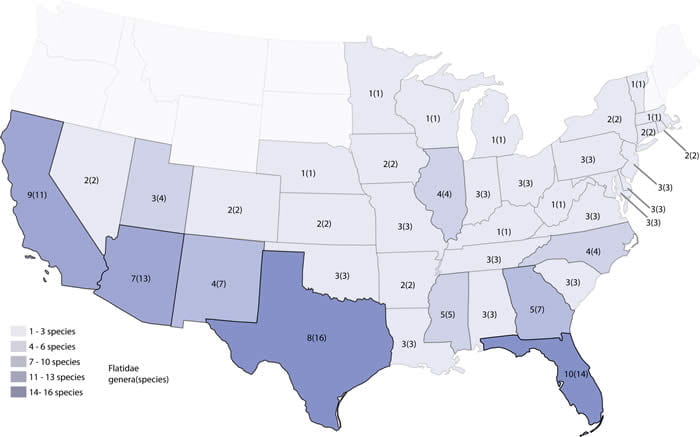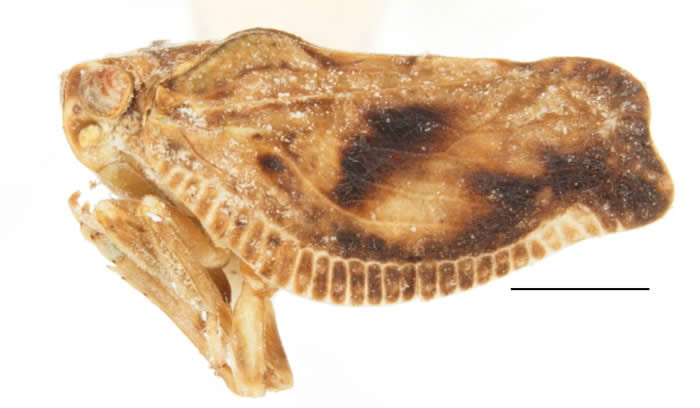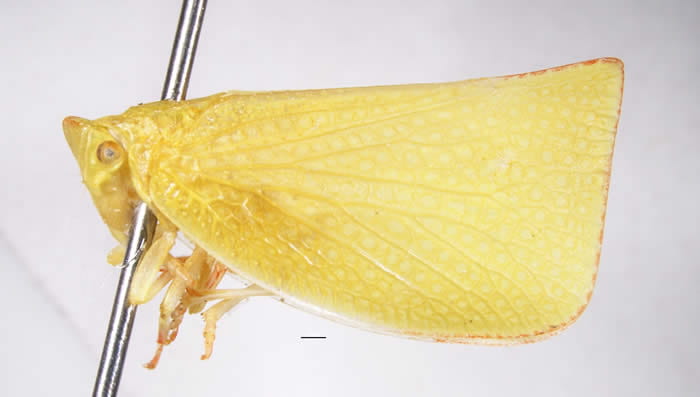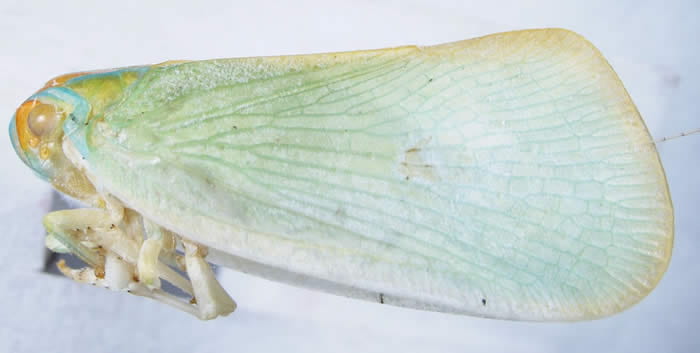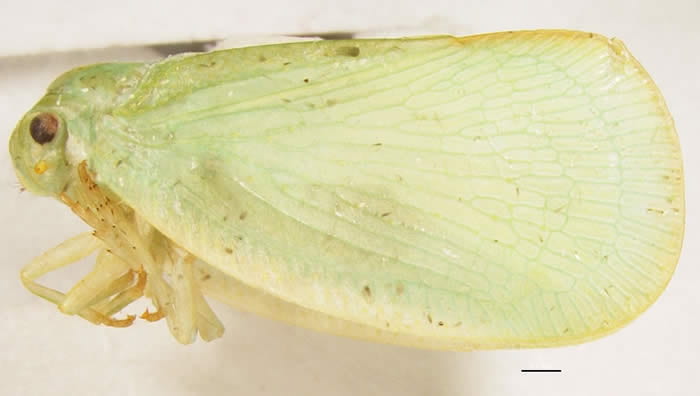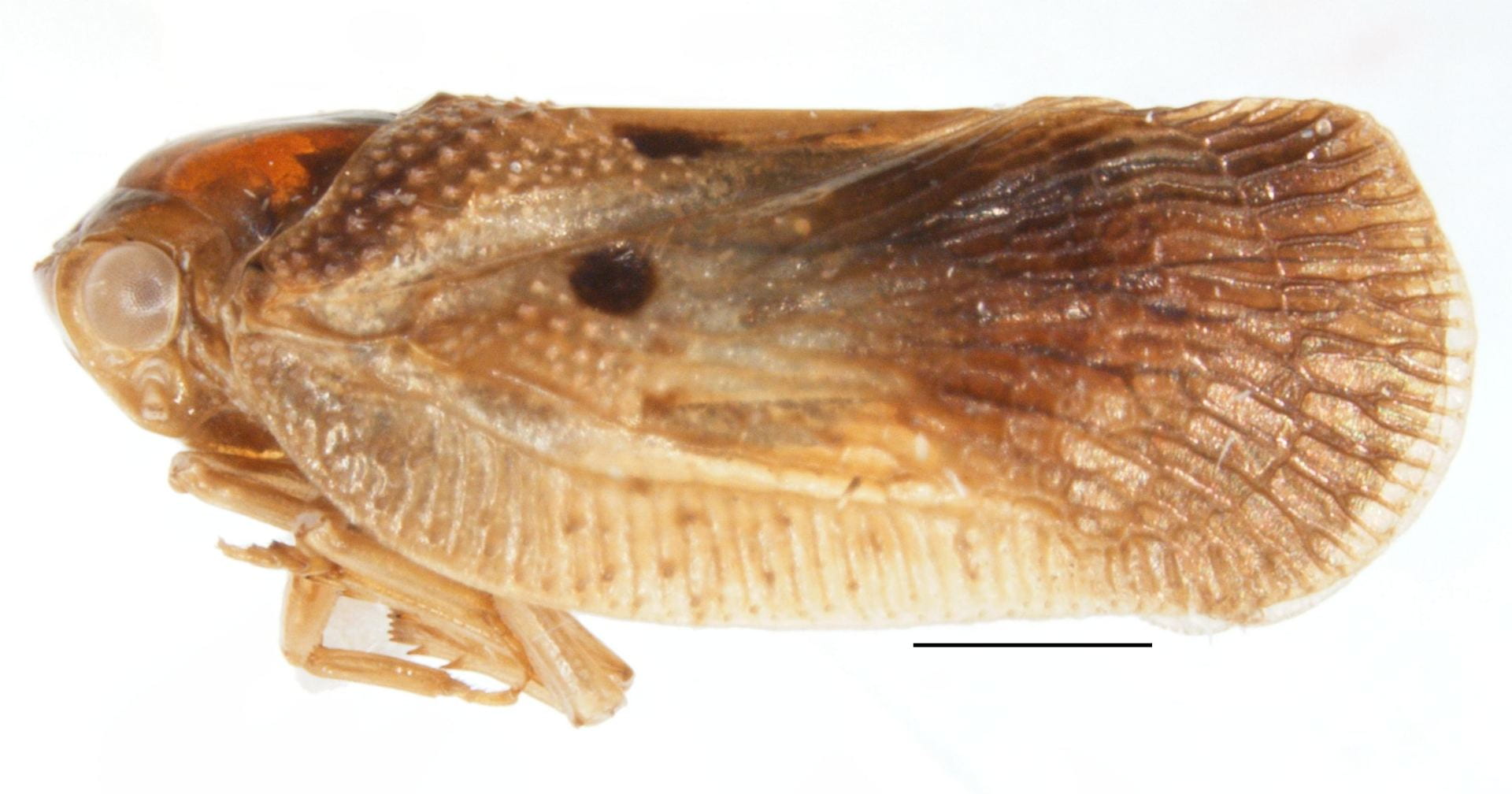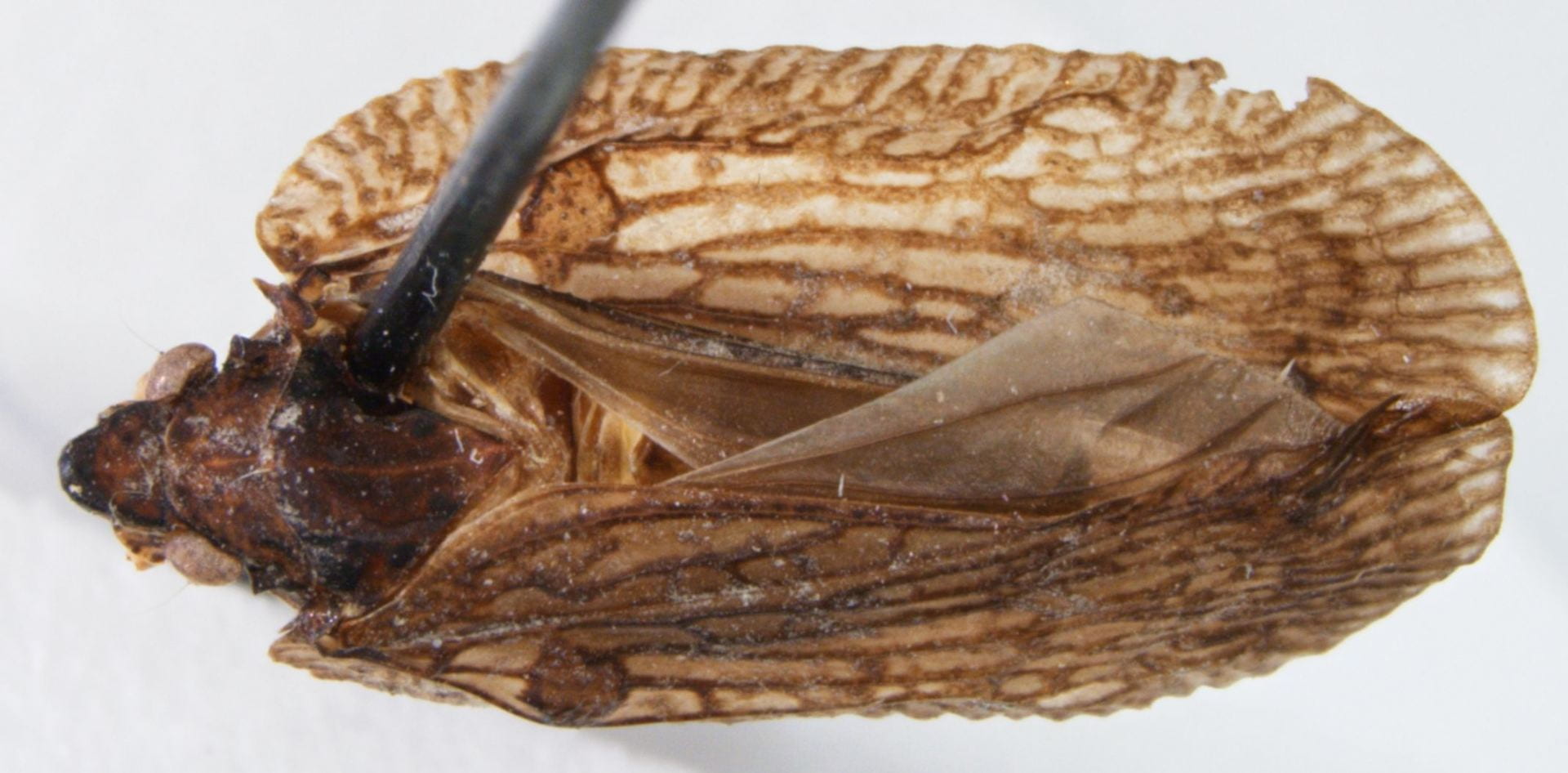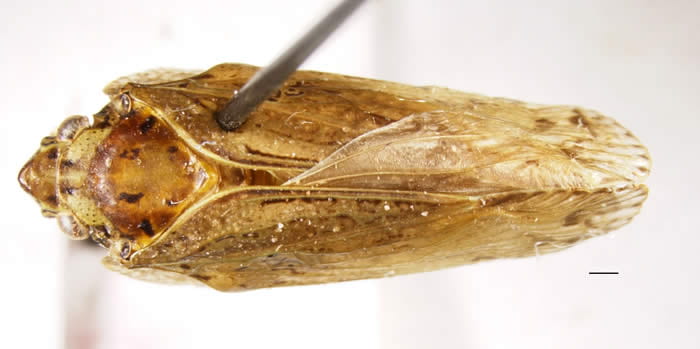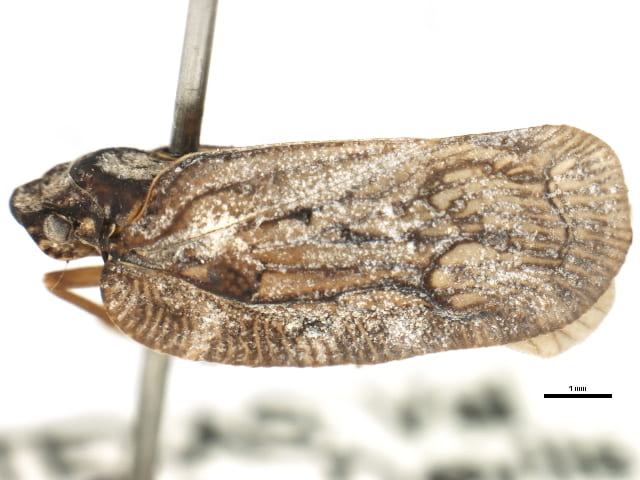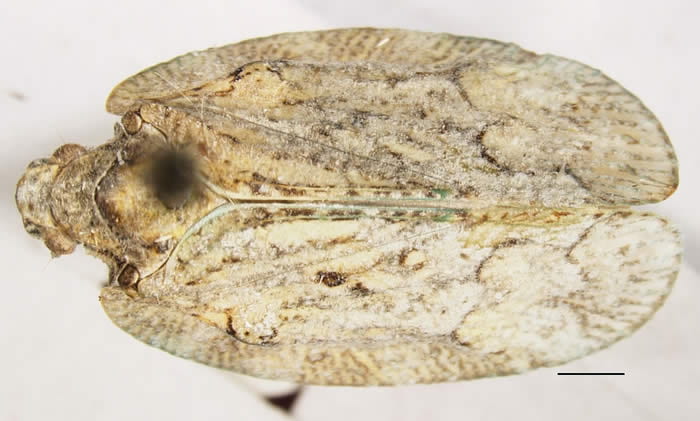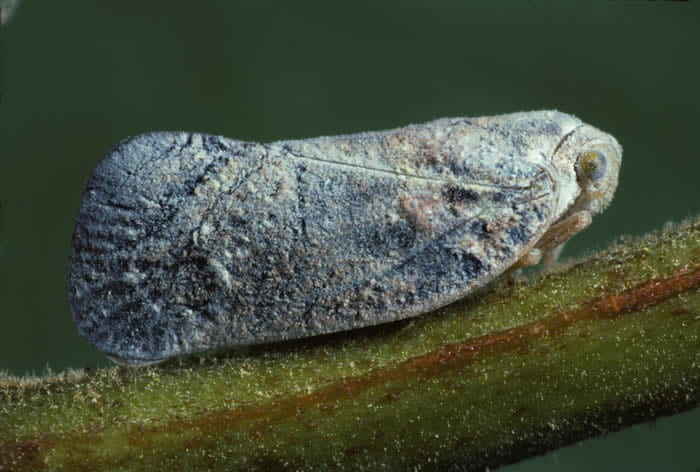
Metcalfa pruinosa (Flatinae: Nephesini); Photo by Dave Funk, Stroud Water Research Center (used by permission).
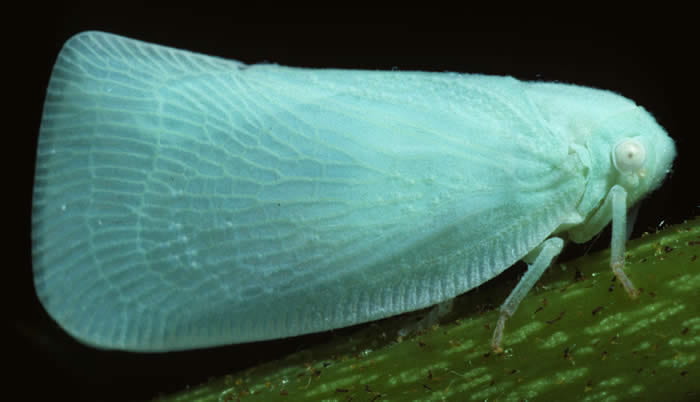
Flatormenis proxima (Flatinae: Nephesini); Photo by Dave Funk, Stroud Water Research Center (used by permission).

Unidentified flatid nymph (Flatinae, prob. Nephesini) (Costa Rica, Rancho Quemado, Peninsula de Osa); photo by Anna Labarre (used by permission and with gratitude). (Similar one from Panama here: http://www.flickr.com/photos/artour_a/2074867104/)
Flatidae is the 4th largest family of planthoppers, consisting of 299 genera and 1,446 species (Bourgoin 2012). The higher taxonomy of Flatidae has not been recently examined and this follows Metcalf (1957). The composition of the family has seldom been questioned, unlike most families of derived Fulgoroidea. The described U.S. flatid fauna consists of 13 genera and 27 species. Flatidae is most diverse in the south, with only a few widely distributed species in northern states. All genera of flatids north of Mexico have additional species found in the Neotropics, except Ormenaria, and the adventive Siphanta. Mistharnophantia is reported as far south as Oaxaca, Mexico.
Flatids are most readily recognized by the presence of a ‘submarginal vein’, paralleling the wing margin, defining a series of marginal cells in the apical and leading portion of the front wings, and the presence of wax bearing pustules in the claval region. In the leading portion of the wing (the pronating complex of Dworakowska 1988), the costal vein subtends a ‘precostal area’ containing the marginal cells, a feature most evident in flatids (among families north of Mexico), although a ‘precostal area’ is found in other higher planthopper families (e.g., Fulgoridae, Fennah 1944). Therefore, the costal vein is not the leading margin of the wing, but the first longitudinal vein following. Like other higher planthoppers, this family has 2 spines on the second tarsomere of the hind legs. The most common flatids have broad wings, held parallel to the body in repose, resembling acanaloniids; although Selizini (Cyarda, Mistharnophantia and Paradascalia) have the wings narrowed apically, and Flatoidinae (Flataloides, Flatoides, Flatoidinus, Metcracis and Pseudoflatoides) are dorsoventrally flattened.
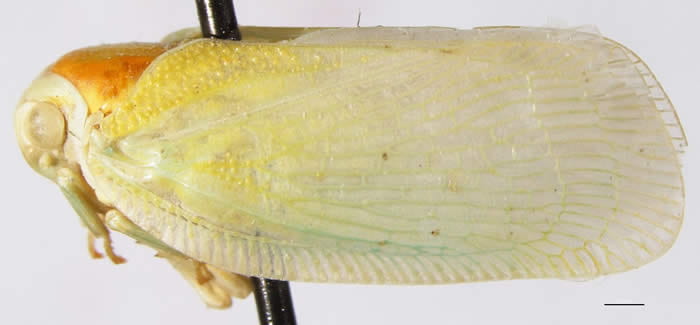
Flatormenis saucia (Flatinae: Nephesini) showing pustules in the claval region and the ‘submarginal vein.
Keys to genera that include western taxa are lacking, and only Mistharnophantia has been treated on the generic level (Doering & Shephard 1946), although Cyarda is being revised, and most other genera have few North American species. Species records of Cyarda should be treated with caution since early workers may not have used genitalia and some species limits remain in doubt. Some tropical species of Cyarda appear to approach Paradascalia in general appearance, and there may be overlap of features among these genera. Records of Metcalfa pruinosa from the western U.S. and Neotropics require verification because this species can be confused with a variety of gray or dark flatids, and most authors did not use genitalic features for species verification.
Nine species have been previously reported from the U.S. in error, including Antillormenis contaminata, Flatoidinus acutus,Flatoidinus occidentis, Hesperophantia ricanoides, Leptormenis relicta, Melormenis conformis (a synonym of Ketumalabisecta from Sri Lanka), Melormenis infuscata, Pseudoflatoides tortrix and Pseudoflatoides insularis (Bartlett et al. 2014). The species limits of some common taxa require review. There are several undescribed species from the southern U.S.
Essentially all genera of North American flatids need revision, particularly Nephesini (Flatinae) and Flatoidinae, probably in combination with molecular studies to assist in the formulation of both generic and species concepts. There is considerable confusion about the generic placement of many species, particularly among Flatoidinae, which are uncommon in collections and have phonetically similar generic names. The types of many species were examined by the late John Medler (e.g., Medler 1986, 1990, 1993, 1994, 1996, 2003), with many generic rearrangements, but not all taxa were reviewed and an integrative work was never completed. Medler’s unpublished notes suggest that some external features, such as color and details in wing venation, vary substantively among specimens and may not be fully satisfactory for species determination. Within Flatoidinae, several putative generic features showed substantive variation among species, or even specimens (in the case of lateral spines of the hind tibiae for Metcracis).
Medler (1993) examined the type of Flatoides scabrosus Melichar, 1902 from Brazil and concluded that this species belonged to the genus Flataloides Metcalf, 1938. He reported that specimens from North Carolina were correctly identified as this species (but not the specimen illustrated in Metcalf, 1923). Medler (1993) also described the genus Metcracis for 11 Neotropical species formerly placed in the Old World genus Atracis Stål, 1866, which are species similar to Flataloides, but with 1 lateral spine on the hind tibiae.
Adults and immatures of flatids are found on the above-ground portions of a wide variety of woody and semi-woody plants. The life history of 3 flatid species (Ormenoides venusta, Metcalfa pruinosa, Flatormenis proxima [as Anormenis septentrionalis]) are described in Wilson & McPherson (1981). All three species were univoltine, overwintering as eggs and polyphagous. The biology of Ormenaria rufifascia was discussed in Wilson & Tsai (1984). Ormenaria rufifascia is univoltine and feeds on palms (Sabal palmetto (Walter) Lodd. ex Schult. & Schult. f. and the exotic Latania lontaroides (Gaertn.) H.E. Moore). Clausen (1978) reviewed the parasites and predators of flatids.
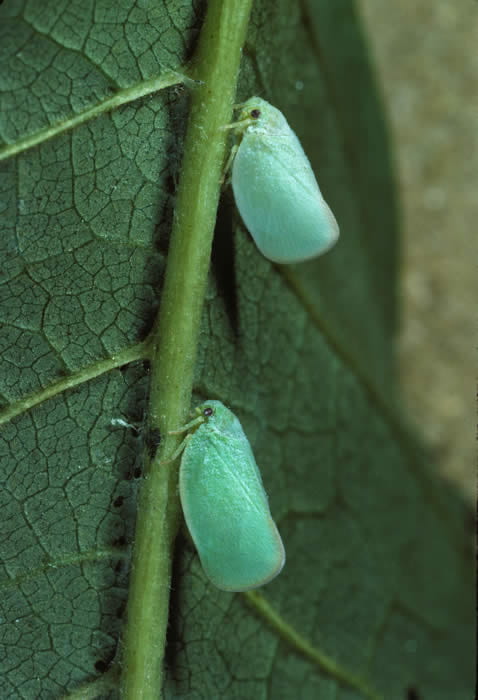
Ormenoides venusta (Flatinae, Nephesini); Photo by Dave Funk, Stroud Water Research Center (used by permission).

Cyarda sp (Flatinae: Selizini) from Florida (Photo by Kimberley Shropshire, Department of Entomology, University of Delaware).
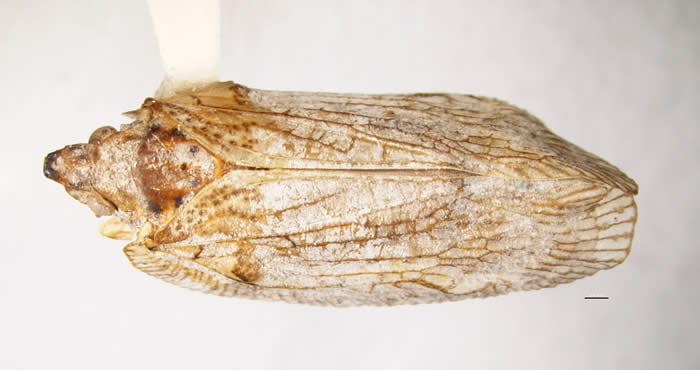
Pseudoflatoides tortrix (Flatoidinae) from Baja California Sur, Mexico (Photo by Kimberley Shropshire, Department of Entomology, University of Delaware).
Synopsis of flatid genera north of Mexico.
Flatinae Spinola, 1839
Flatini Spinola, 1839
Hesperophantia Kirkaldy, 1904 (Type species Poeciloptera caudata Stål, 1862) (replacement name for unavailable CarthaeaStål, 1862).
Siphanta Stål, 1862 (Type species Poeciloptera acuta Walker, 1851).
Nephesini Melichar, 1923
Antillormenis Fennah, 1942 (Type species Ormenis contaminata Uhler, 1895).
Flatormenis Melichar, 1923 (Type species Ormenis squamulosa Fowler, 1900).
Leptormenis Melichar, 1923 (Type species Flata relicta Fabricius 1803).
Melormenis Metcalf, 1938 (Type species Cicada quadripunctata Fabricius 1794 (nec. De Villers 1789), replaced by Ormenis antillarum Kirkaldy, 1909).
Metcalfa Caldwell, 1951 (in Caldwell & Martorell 1951) (Type species Flata pruinosa Say, 1830).
Ormenaria Fennah, 1947 (Type species Poeciloptera rufifascia Walker, 1851).
Ormenoides Melichar, 1923 (Type species Ormenis distincta Melichar, 1902).
Petrusa Stal, 1962 (Type species Cicada marginata Brunnich in Linneaus, 1767: 710).
Selizini Melichar, 1923
Cyarda Walker, 1858 (Type species Cyarda difformis Walker, 1858).
Mistharnophantia Kirkaldy, 1907 (Type species Mistharnophantia sonorana Kirkaldy, 1907).
Paradascalia Metcalf 1923 (Type species Cicada grisea Fabricius, 1775).
Flatoidinae Melichar, 1901
Flatoidini Melichar, 1901
Flataloides Metcalf, 1938: 402 (Type species Elidiptera obliqua Walker 1858: 70).
Flatoides Guérin-Méneville, 1844 (Type species Flatoides tortrix Guérin-Méneville, 1844).
Flatoidinus Melichar, 1923 (Type species Poeciloptera conviva Stål, 1862).
Metcracis Medler, 1993 (Type species Elidiptera humeralis Walker, 1858).
Pseudoflatoides Metcalf, 1938 (Type species Flata (Phalaenomorpha) tortrix Guérin-Méneville, 1856).
Key to genera of Flatidae north of Mexico (Modified from Bartlett et al. 2014; photos Kimberley Shropshire, Dept. Entomology, University of Delaware).
Note: Genera reported from the U.S. in error are included in this key except Hesperophantia, which does not appear to be correctly placed to genus, and Ketumala, which is not a New World genus.
1. Wings narrowed distally in lateral view (Selizini) – 2
1.’ Wings broad distally – 4
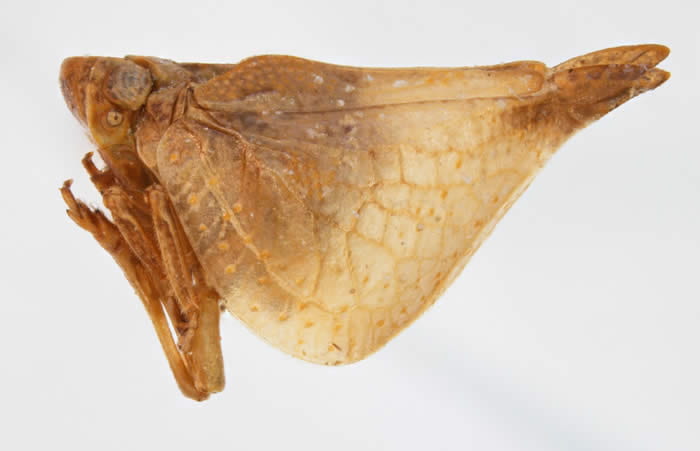
Mistharnophantia sp. (Arizona) (photo by Kimberley Shropshire, University of Delaware, Department of Entomology
2. Wings strongly narrowed to acute apices – 3
2.’ Wings weakly narrowed, weakly bilobed on apical margin – Paradascalia Metcalf
3. Wings elongate, 3-4x as long as broad, apical margin obliquely truncate, in U.S. mostly southeastern – Cyarda Walker
3.’ Wings not elongate, slightly longer than broad, produced into an acute point, southwestern –
Mistharnophantia Kirkaldy
4. Wings at rest held parallel to body (Nephesini and Siphantini) – 5
4.’ Wings at rest held tent-like; having appearance of being dorsoventrally flattened (Flatoidinae) – 13
5. Vertex conical, anteriorly pointed; adventive into California (Siphantini) – Siphanta Stål
5.’ Vertex short, nearly linear anteriorly (Nephesini) – 6
6. Distal veins of forewing in repose strongly arched ventrad – Leptormenis Melichar
6.’ Distal veins of forewings not strongly arched ventrad – 7
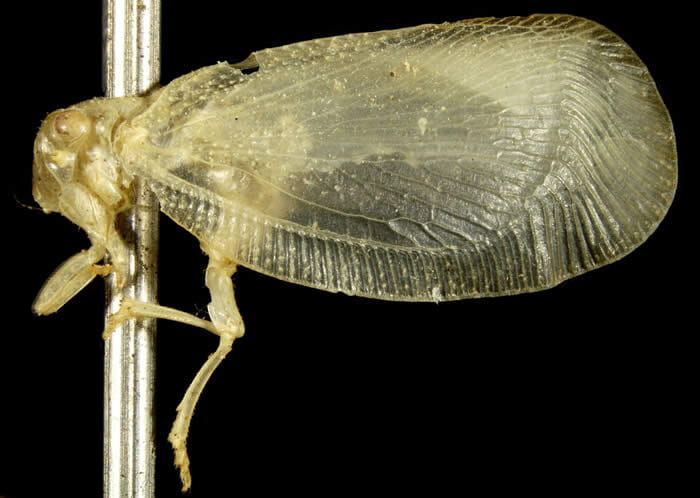
Leptormenis relicta (Nephesini) (holotype, photo courtesy Niels Kristensen, University of Copenhagen, Natural History Museum of Denmark)
7. Body predominately green – 8
7.’ Body predominately brown, grey or red shades – 10
8. Body marked with red; either head and thorax with parallel red lines (O. rufifascia; southeastern); or front and middle tibiae marked with red (O. barberi, western) – Ormenaria Fennah
8.’ Body not marked with red – 9
9. With 1 subapical vein on forewings; wings rounded apically; frons about as tall as wide (h:w ratio ca. 0.9:1) – Ormenoides Melichar
9.’ With 2 subapical veins on forewings; wings truncate apically; frons much wider than tall (h:w ratio ca. 0.5-0.7:1) –Flatormenis Melichar
Ormenoides venusta
10. With 1 subapical vein on forewing – 11
10.’ With 2 subapical veins on forewing – 12
11. Wings slightly tectiform, in lateral view dorsal and ventral wing margins subparallel; usually brownish, sometimes with contrasting costal area; southern, adventive in Florida – Melormenis Metcalf
11.’ Wings held parallel to sides of body, wings in lateral view widest subapically; grayish to blackish species without contrasting costal area; abundant powdery wax on wings and body; common and widespread – Metcalfa Caldwell
12. Frons truncate at frontoclypeal suture, frons slightly wider than long (h:w ratio 0.7-0.8:1); mesonotum brownish; wings often extensively pale, with white costal area (Caribbean taxa, reported, but not confirmed from U.S.) – Antillormenis Fennah
12.’ Frons concave at frontoclypeal suture, frons wider than long (h:w ratio 0.5-0.7:1); mesonotum often orangish, contrasting with body (body color variable); usually without contrasting costal area – Flatormenis Melichar
Flatoides enota
13. Vertex distinctly longer than broad – 14
13.’ Vertex broader than long – 15
14. In lateral view, thorax distinctly raised relative to head; vertex smoothly rounded to apex; southwestern U.S. – Flatoides Guérin-Méneville
14’. In lateral view, thorax only slightly raised relative to head; vertex with sides parallel in part; Caribbean taxa, reported but not confirmed in U.S. – Pseudoflatoides Metcalf
Pseudoflatoides tortrix
15. In dorsal view, front of head rather pointed, projected in front of eyes; frons without median trough – Flatoidinus Melichar
15.’ In dorsal view, front of head truncate or weakly rounded; frons with weak median trough with bordering carinae (becoming obsolete ventrally) – 16
16. Frons with a dark band on anterior third; often only 1 lateral spine on hind tibiae (sometimes 2, check both legs); many longitudinal veins forked at subapical vein; dark brown; Texas and west – Metcracis Medler
16′ Frons without dark band; 2 lateral spines on hind tibiae; longitudinal veins not forked at subapical vein; dark or pale species; Texas and east Flataloides Metcalf
Selected References (still adding references; older references can be found by searching Dr. Metcalf)
Bartlett, C. R., L. B. O’Brien and S. W. Wilson. 2014. A review of the planthoppers (Hemiptera: Fulgoroidea) of the United States. Memoirs of the American Entomological Society 50: 1-287.
Bourgoin, T. 2012. FLOW (Fulgoromorpha Lists on The Web): a world knowledge base dedicated to Fulgoromorpha. Version 8, updated June 5, 2012. http://flow.snv.jussieu.fr/ (accessed June 5, 2012).
Caldwell, J. S. and L. F. Martorell. 1951 [dated1950]. Review of the Auchenorynchous [sic] Homoptera of Puerto Rico. Part II. The Fulgoroidea except Kinnaridae. Journal of Agriculture of the University of Puerto Rico 34(2): 133-269.
Clausen, C. P. 1978. Introduced parasites and predators of arthropod pests and weeds: A world review. Flatidae. U S Department Of Agriculture, Agriculture Handbook No. 480: 131.
della Giustina, W. 1986. Metcalfa pruinosa (Say), nouveauté pour la fauna de France (Hom.: Flatidae). Bulletin de la Societé Entomologique de France 91: 89-92.
Dlabola, J. 1981. Metcalfa pruinosa (Say, 1830), eine schädliche nordamerikanische Flatide als Erstfund in der Palaearktis. Faunistische Abhandlungen – Staatliches Museum für Tierkunde Dresden 8(9): 91-94.
Doering, K. C. and C. J. Shepherd. 1946. Some new species of the genus Mistharnophantia (Subfamily Flatinae, Family Fulgoridae, Homoptera). Journal of the Kansas Entomological Society 19: 111 127.
Dworakowska, I. 1988. Main veins of the wings of Auchenorrhyncha (Insecta, Rhynchota, Hemelytrata). Entomologische Abhandlungen Staatliches Museum für Tierkunde Dresden 52(3): 63-108.
Fennah, R. G. 1941. Notes on the flatid genus Ormenis in the British Lesser Antilles and Trinidad, with descriptions of new species (Homoptera: Fulgoroidea). Proceedings of the Entomological Society of Washington 43(9): 191-210.
Fennah, R. G. 1942. Notes on some West Indian Flatidae. Proceedings of the Entomological Society of Washington 44(8): 155-167.
Fennah, R. G. 1944. The Morphology of the tegmina and wings of the Fulgoroidea (Homoptera). Proceedings of the Entomological Society of Washington 46(7): 185-199.
Fennah, R. G. 1945. The Fulgoroidea, or lanternflies, of Trinidad and adjacent parts of South America. Proceedings of the United States National Museum 95(3184): 411-520.
Fennah, R. G. 1947. Notes on West Indian Flatidae (Homoptera Fulgoroidea). Proceedings of the Biological Society of Washington 60: 107-117.
Fletcher, M. J. 1985. Revision of the genus Siphanta Stål (Homoptera: Fulgoroidea: Flatidae). Australian Journal of Zoology, Supplementary Series No. 110: 1 94.
Fowler, W. W. 1900. Order Rhynchota. Suborder Hemiptera-Homoptera. (Continued). Key to the genera of the subfamily Flatinae with descriptions of the new species. Biologia Centrali-Americana 1: 49-56.(http://www.sil.si.edu/DigitalCollections/bca/navigation/bca_18_01_00/bca_18_01_00.cfm?start=649)
Gnezdilov, V. M. and E. S. Sugonyaev. 2009. First record of Metcalfa pruinosa (Homoptera: Fulgoroidea: Flatidae) from Russia. Zoosystematica Rossica 18: 260-261.
Guérin-Méneville, F. E. 1844. Insectes. Pp. 355-370. In: Cuvier G. L. C. F. D. 1844. Iconographie du règne animal. J. B. Baillière, Paris.
Guérin-Méneville, F. E. 1856. Segunda, Seccion. Homopterous. In: Crustaceos,aragnides, e insectos. Pp. 178-182. In: Ramon de la Sagra D. 1856. Historia fisica politica y natural de la Isla de Cuba. Segunda Parte Historia Natural, volume 7. A. Bertrand, Paris.
Kirkaldy, G. W. 1904. Bibliographical and nomenclatorial notes on the Hemiptera No. 3. Entomologist 37: 279-283.
Kirkaldy, G. W. 1907. Leafhoppers. Hemiptera Homoptera. Bulletin of the Hawaiian Sugar Planters’ Association Experiment Station, Division of Entomology 4: 60-66.
Lee, H.-S. and S. W. Wilson. 2010. First Report of the Nearctic flatid planthopper Metcalfa pruinosa (Say) in the Republic of Korea (Hemiptera: Fulgoroidea). Entomological News 121: 506-513.
Lucchi, A. and E. Mazzon. 2004. Wax production in adults of planthoppers (Homoptera: Fulgoroidea) with particular reference to Metcalfa pruinosa (Flatidae). Annals of the Entomological Society of America 97: 1294-1298.
Medler, J. T. 1986. Types of Flatidae (Homoptera) XII. Taxonomic notes on Guerin-Meneville types in the Naples Museum, with illustration of male genitalia of Plesiotypes for the respective species. Bollettino del Laboratorio di Entomologia Agraria Filippo Silvestri 43: 11-20.
Medler, J. T. 1990. Types of Flatidae (Homoptera). XIV. Walker and Distant types in the British Museum (England, UK.) Oriental Insects 24: 127-195.
Medler, J. T. 1993. Types of Flatidae (Homoptera) XVIII. Lectotype designations for Fowler and Melichar type specimens in the Museum of Natura History in Vienna, with 2 new genera and a new species. Annalen des Naturhistorischen Museums in Wien Serie B Botanik and Zoologie 94-95(B): 433-450.
Medler, J. T. 1994. Types of Flatidae (Homoptera) in the Stockholm Museum with lectotype designations. Part 2. Entomologica Scandinavica 25: 215-225.
Medler, J. T. 1996. Types of Flatidae XXII. E. Schmidt types in the Warsaw Museum and other museums (Homoptera: Flatidae). Bulletin of the Museum and Institute of Zoology PAS 1: 135-151 (supplement to Annales Zoologici).
Medler, J. T. 2003. Types of Flatidae. XXIV. Type designations and taxonomic notes on species in the Natural History Museum of Geneva (Homoptera, Auchenorrhyncha, Fulgoroidea). Revue Suisse de Zoologie 110: 591-597.
Melichar, L. 1901. Monographie der Acanaloniiden und Flatiden (Homoptera). Annalen des k. k. Naturhistorischen Hofmuseums 16: 178-258.
Melichar. L. 1902. Monographie der Acanaloniiden und Flatiden (Homoptera) (Fortsetzung). Annalen des k.k Naturhistorischen Hofmuseums 17: 1-253.
Melichar, L. 1923. Homoptera, fam. Acanalonidae, Flatidae et Ricaniidae. Genera Insectorum. 182: 1-185.
Metcalf, Z. P. 1938. The Fulgorina of Barro Colorado and other parts of Panama. Bulletin of the Museum of Comparative Zoology, Harvard Coll. 82: 277-423. [from http://www.biodiversitylibrary.org]
Metcalf, Z. P. 1957. General catalogue of the Homoptera. Fasc. IV. Fulgoroidea, Part 13. Flatidae and Hypochthonellidae. North Carolina State University, Raleigh, NC. 565 pp.
Metcalf, Z. P. and S. C. Bruner. 1948. Cuban Flatidae with new species from adjacent regions. Annals of the Entomological Society of America 41: 63-118.
O’Brien, L. B. 1985. New synonymies and combinations in New World Fulgoroidea (Achilidae, Delphacidae, Flatidae, Fulgoridae: Homoptera). Annals of the Entomological Society of America 78: 657-662.
Say, T. 1830a. Descriptions of new North American hemipterous insects, belonging to the first family of the section Homoptera of Latreille. Journal of the Academy of Natural Sciences of Philadelphia 6: 235-244.
Shepard, C. L. 1939. The genus Ormenis (Fulgoridae) in North America north of Mexico. Unpubl. M. A. Thesis, University of Kansas. 60 pp. 8 plates.
Spinola, M. 1839. Essai sur les Fulgorelles, sous-tribu de la tribu des Cicadaires, ordre des Rhyngotes. Annales de la Société Entomologique de France 8: 133-337, 339-454.
Stål, C. 1862. Bidrag till Rio de Janeiro-tratkens Hemipterfauna.II. Handlingar. Kongliga Svenska Vetenskaps Akademien 3(6): 1-75.
Uhler, P. R. 1895a. An enumeration of the Hemiptera-Homoptera of the Island of St. Vincent, W. I. Proceedings of the Zoological Society of London 1895: 55–84.
Walker, F. 1851. List of the specimens of Homopterous Insects in the collection of the British Museum. British Museum, London. 2: 261-636.
Walker, F. 1858b. Supplement. List of the specimens of Homopterous Insects in the collection of the British Museum 1858: 1-307.
Wheeler, A. G., Jr. and E. R. Hoebeke. 1982. Host plants and nymphal descriptions of Acanalonia pumila and Cyarda sp. near acutissima (Homoptera, Fulgoroidea: Acanaloniidae and Flatidae). Florida Entomologist 65(3): 340-349.
Wilson, S. W. and J. H. Tsai. 1984. Ormenaria rufifascia (Homoptera: Fulgoroidea: Flatidae): descriptions of nymphal instars and notes on field biology. Journal of the New York Entomological Society 92: 307-315.
Wilson, S. W. and J. E. McPherson. 1981. Life histories of Anormenis septentrionalis, Metcalfa pruniosa, and Ormenoides venusta with descriptions of immature stages. Annals of the Entomological Society of America 74: 299-311.
Wilson, S. W., C. Mitter, R. F. Denno and M. R. Wilson. 1994. Evolutionary patterns of host plant use by delphacid planthoppers and their relatives. pp. 7-113. In: R. F. Denno and T. J. Perfect (eds.). Planthoppers: Their Ecology and Management. Chapman and Hall, New York.

